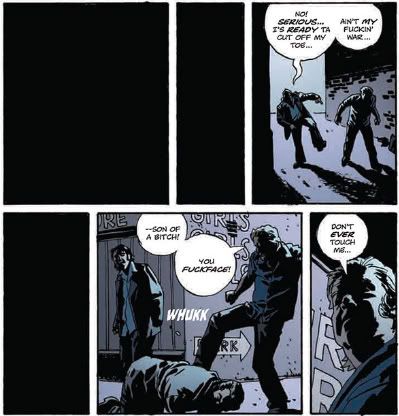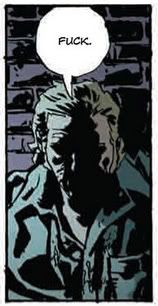All Systems Intact, the Red and the Black: Douglas Looks at DC Universe Zero
/![]() Yeah, this one's spoilery. Not that everything hasn't been spoiled elsewhere, but I'm still putting this under the cut. Not a review, really, but annotations; if you want a rating, I thought it was Excellent as a teaser and value-for-money--I want to read what happens next--and n/a as a story.
Yeah, this one's spoilery. Not that everything hasn't been spoiled elsewhere, but I'm still putting this under the cut. Not a review, really, but annotations; if you want a rating, I thought it was Excellent as a teaser and value-for-money--I want to read what happens next--and n/a as a story.
Pg. 1: It's somehow fitting that, on the first page of a multi-title arc that will apparently draw on Jack Kirby's multi-title arc very heavily (and by the way, Jeff, that's a fantastic post right there), we get a tribute to one of his signature artistic techniques, the extreme long shot. This page seems to have been a last-second rewrite: in the version included in the New York Comic-Con program, the caption was "I am... everything." The present version's better by far. Note also that the captions start with a black background, and that the red creeps in from the right as the story progresses.
Also worth reading: George Pérez's comments on why this page and pg. 3 are "the simplest pages I've ever drawn."
Pg. 3: The first mention of red this issue--the infamous "red skies" of Crisis on Infinite Earths, which were sometimes about the only sign of tie-ins in other titles.
Pg. 5: It wouldn't be a Geoff Johns comic without dismemberment, but at least this character's meant to be one-handed--and "hands" are going to be a running theme in this comic, so take note. ("We could use a hand out here" appears on this page, too.) Tyr's name is the first direct reference to a god this issue, specifically Týr, the god of fistfights and single combat, a concept with which superhero comics of the era now ending are too familiar. This particular version of Tyr first appeared here, created by Cary Bates and the late Dave Cockrum.
Superman is wearing his Legion flight ring on his middle finger, oddly (it's on his ring finger here, as are the Legionnaires with visible rings on the next page. And can anyone identify the woman with Brainiac 5 and the White Witch?
Pg. 7: This appears to be the inked version of the preview image from a few months ago. I'm happy to see Night Girl (in the lower right-hand corner) again, although the peekaboo cut-outs on her costume's owl are sort of creepy. Also, note the building halfway down the right side: it's the 31st century HQ of the Daily Planet! And people say newspapers are doomed!
Pg. 8: A callback to the opening scene of The Killing Joke, of course, because Morrison can't stop slaying/honoring Highfather Moore. And here we go with red and black again... the version of the Joker follows on from this scarier version, rather than the one we've been seeing in Salvation Run.
Pg. 9: In The Killing Joke, the fake Joker of the opening scene seemed to be playing some solitaire variation of Klondike; here, the real one is just dealing cards. (In panel 4, he's doing a fancy shuffle--for a second I thought he was building a house of cards.) The Black Glove has been making mostly-offstage appearances in Batman, and this possibly extremely spoilery link goes to a very convincing theory by David at Funnybook Babylon on who the Opposite-of-White Glove is.
Pg. 10: Harlequin pattern on the card echoed not just by the floor but by the layout and color scheme of the page: nice! (And both the color-scheme trick and the splatter of blood on the card can't help but recall Watchmen...)
The "dead man's hand" is two aces, two eights and something else (here, cleverly, the wild card), supposedly the hand Wild Bill Hickcock was holding when it was shot. (The aces and eights are usually all black, but this fits the symbolic scheme of the scene and the issue better.) The term also recalls the Hand of Glory from The Invisibles; the hand missing a finger echoes the assailant from the most recent issue of Batman, and also suggests the name of Batman mastermind Bill Finger!
Pg. 12: I would like to congratulate myself on predicting the name of the Red Volcano almost two years ago. (Anyone want to predict who the water-elemental equivalent of R.V., the Red Tornado and the Red Inferno is going to be?)
Professor Ivo, of course, is the creator of Amazo. Doctor Poison first appeared here, although the one we're dealing with is most likely her grandchild, who first appeared here. I have no idea who that is in the Darfur scene; any thoughts?
Remember, kids, eating people is wrong!
Pg. 14: Anybody happen to know if the caption here references something Hal ever told Barry on-panel? In any case, Black Hand first appeared here, and continues the blackness/hands/Black Glove series. Hal, as the Spectre, burned Black Hand's right hand off here--it would appear that the right handprint is the one burned into the victim's chest, but he's able to reconstruct his hand by draining people's life force.
Is the "federal penitentiary" Salvation Run?
Pp. 15-16: The rainbow Lantern Corps were established in Green Lantern #25. In Roy G. Bivolo order, their motivating forces are rage, greed, fear (is that a Monitor?), will, hope, compassion, and love. And would that be a white lantern in the last panel? Or a black lantern? Apparently the ring in the Blackest Night previews is a Black Hand ring.
Pp. 17-18: Would someone who read Countdown maybe take a stab at what's going on here? Like, did Crispus shave?
Pg. 19: As far as I can tell, there's no DCU character named Carr D'Angelo, but there is a real-world person who produced The Hot Chick. Which was an awful movie, but I think the Spectre's response is a little extreme. Also: "I am somebody!" And I guess, from that ad, that it is "Revelations" with an S. Too bad.
Pg. 20: More of the 2-D/3-D play that Morrison's Seven Soldiers made so much of, especially Seven Soldiers: Mister Miracle. The reddish and blackish planets in the first panel might be Apokolips and New Genesis, although it looks like there's more of a nature/tech dichotomy than a good/evil dichotomy going on there. And the falling character: would that be The Human Flame? Looks a little like The Ray, actually.
Pg. 21: "A runner poised on the line": yes, that runner. Doesn't this scene remind you of the Hood gathering all the bad guys in New Avengers a few months ago? Libra first appeared here, and at the end of that story, he became, in the words of some long-ago issue of E-Man, "several with the universe"--in other words, the position the narrator of this issue claims to be in at the beginning. It's not clear from that JLA issue what color Libra's eyes are--there's only one panel in which his eyes are visible, and they're colorless--but here they're definitely blue. As in the same color as the Flash's eyes in that Final Crisis poster. Anybody want to identify which copy of the Crime Bible this is?
Pg. 23: "Believe in him, that's all he asks!" Not only is this very much like the "he loves you" business going on in Secret Invasion, it explicitly echoes the "believe in her" refrain chanted by Lady Styx's followers. And Lady Styx, of course, makes the dead rise...
Then, of course, we have the matter of the hand clutching something that looks like Kirby-dot energy--the culmination of this issue's hand imagery. I've written about the giant-hand-in-space motif before, but the short version is that it seems to be the closest thing DC has to a creation-story icon; maybe it's present here to signify the beginning of the Fifth World, or the end of the Fourth, or maybe there's something else going on.
This, I believe, is the first time in many years--maybe even post-Crisis?--that the Secret Society of Super-Villains has been referred to by its full name, rather than simply as the "Secret Society." (Incidentally, the third page of 52 #1 referred to a rampage by the "Monster Society"; in the trade paperback, that's been corrected to "Secret Society.") It's weird to see them calling it that; as the final chapter title of "The Lightning Saga" put it, "the villain is the hero in his own story."
"And this is me": is Barry Libra? And doesn't one usually see the lightning before hearing the thunder?
Pg. 24: Lightning plus red sky plus enormously oversized moon equals Flash costume. I assume "Twisters" is where the Society's meeting; Morrison has mentioned that this is where Final Crisis proper begins, an instant after this scene. (Is the club's name a hint at something involving the Red Tornado?)
As for Barry Allen's return--well, I don't really understand why that's an alert-the-media! big deal, since it's got what Wikipedia's perfect phrase calls "primarily in-universe" significance. I'm not exactly excited at the prospect of having him back and starring in a monthly Flashcomic, just because I like stories that have ended to stay ended: it makes me more invested in the ones that haven't ended yet. But Johns had Barry popping in from the future in Flash #200 and telling Wally West that that was the first of three times they'd see each other; the second was in #224, and the third hasn't happened yet. (I don't think the cameo via the Speed Force in Infinite Crisis #4 counts. Barry's end-of-career timeline is mostly detailed here.) "The Lightning Saga" teased Barry's return very heavily; I'm sure there are going to be plenty of callbacks to that story in the months to come.
































